Home Building: Now for something completely different
During the past decade major changes in population growth patterns were evident in Virginia. In contrast to what happened in the early 2000s housing boom, when many counties on the edges of urban areas became some of the fastest growing in the country, when the boom ended, these same “exurban” counties declined in population. At the same time, after decades of stagnation and decline, urban centers began to grow again during the early 2000s.
One way to understand these dramatic changes in where Virginia’s population grew is to analyze home construction activity because it is often one of the most reliable indicators of population and economic change.
During the early 2000s, Virginia underwent a real estate boom that mirrored what was occurring nationally in the wake of broadening access to mortgages. In Virginia, home prices rose in many parts of the state during this time, but particularly in larger metro areas. In Fairfax County, for example, the median home sale price more than doubled from $220,000 in 2000 to $545,000 in 2005. Rising home prices forced many home buyers to move farther out from urban areas for affordable homes in the exurbs.
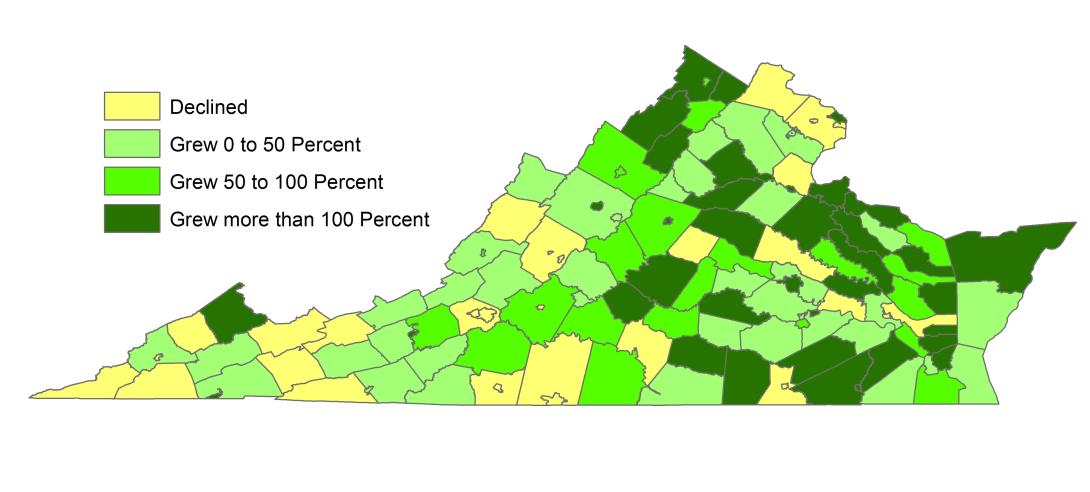
During this same period many rural counties, in which there had been slow growth or decline in prior decades, experienced a surge in new home construction (especially if the counties were within an hour’s drive of metro areas). Counties on the edges of metro areas experienced massive population growth as home buyers moved in. Culpeper County’s population grew by 7 percent just in 2005. A number of other Virginia counties well outside urban areas such as New Kent and Caroline, were among the fastest growing in the country as buyers moved farther away from cities.
As access to mortgages diminished after 2005, home prices began to decline. In Fairfax County, the median home sales price fell 30 percent by 2009. In counties farther from urban areas, home prices fell by more than 50 percent in some instances. Even though homes outside metro areas became even cheaper relative to those in metro areas, other factors, such as a tripling in gas prices since 2001, caused demand to plummet after 2005 for homes in counties farther from job centers. By 2009, the number of new homes constructed in Culpeper County had fallen by 95 percent compared to 2005. Statewide, home construction declined to one-third the number constructed in 2005.
The end of the real estate boom in exurban counties significantly changed their population growth patterns. In Culpeper County in-migration slowed from 2,300 in 2005 to less than 100 annually since 2010. In 2009, Culpeper County’s total population declined for the first time since before 1960. A dozen exurban counties that had experienced population growth rates more than twice Virginia’s average at the height of the housing boom declined in population after 2009.
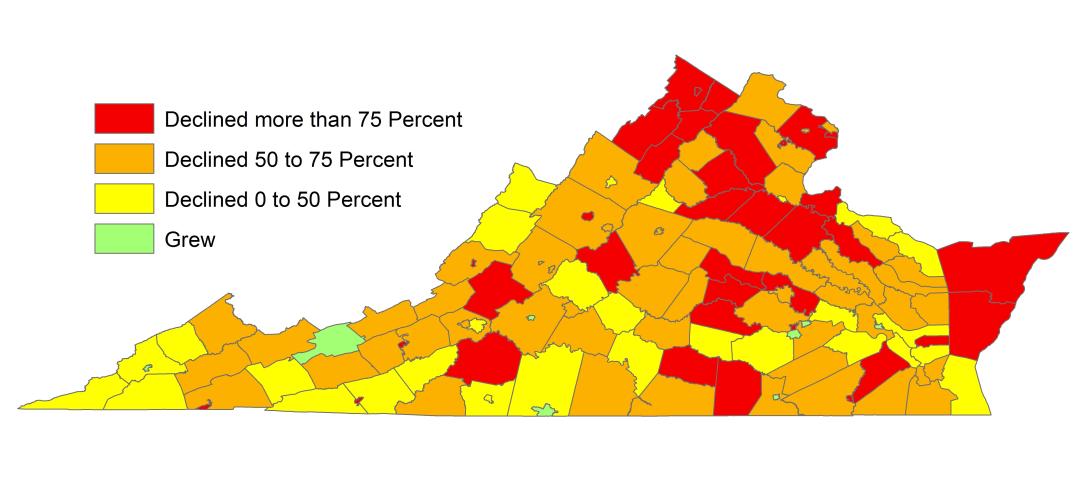
The dramatic reversal experienced by exurban counties in Virginia and across the U.S after the end of the housing boom has led some to describe this change as an inflection point in population growth patterns. Looking at the map of home construction after 2005, signs of this inflection are noticeable, with evidence of a shift in population growth from the outer edges of cities to city centers. Many Virginia counties with the greatest declines in home construction are grouped around the outer edges of metro areas, for example, in Northern Virginia from King George County to Clarke County, and in the Richmond area from Caroline County to Brunswick County.
In contrast, more rapid population growth and smaller declines in home construction were found in urban centers after 2005. Arlington County and Richmond City provide interesting examples. In the decades after 1960, slow growth and population decline characterized both locations. When exurban counties near the Washington and Richmond metro areas received much attention for their rapid growth during the early 2000s, the Washington and Richmond urban centers experienced similar upticks in growth. The increase in building permits issued in Arlington and Richmond after 2000 closely followed increases in the metro exurban counties, Culpeper and Caroline, respectively. But, when the housing boom ended, home construction in urban centers such as Arlington and Richmond did not decline as much as in Culpeper and Caroline, and has rebounded more quickly.
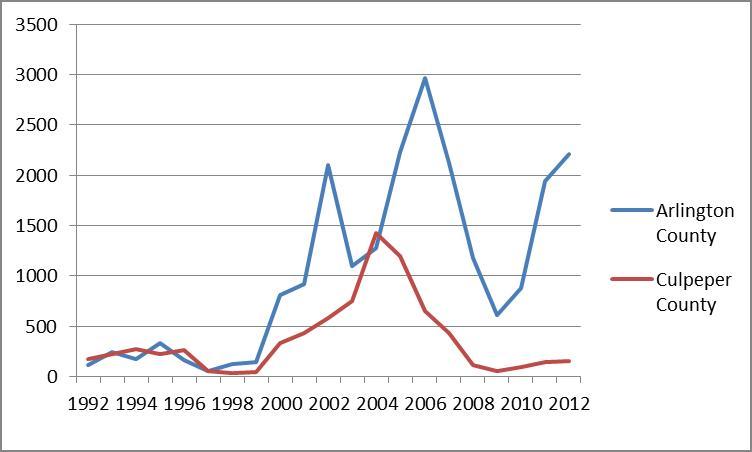
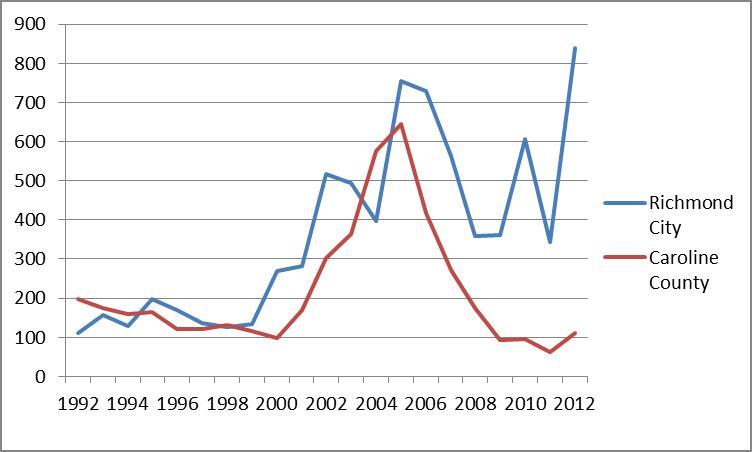
The change in home construction patterns in Northern Virginia and Richmond was more of a divergence between urban and exurban areas than an inversion. This is a break from the past when these areas mirrored each other through boom and bust cycles. Today, the trend is quite different. It appears that growth in many exurban counties was only sustainable in response to soaring home prices in metro area markets. Culpeper County had little home construction until prices soared in Northern Virginia’s main real estate markets after 2000 causing many buyers to look farther out for homes they could afford. The rise in home prices during the early 2000s also caused buyers and developers to look at redeveloping sites in urban centers such as Arlington, which had been largely passed over for decades.
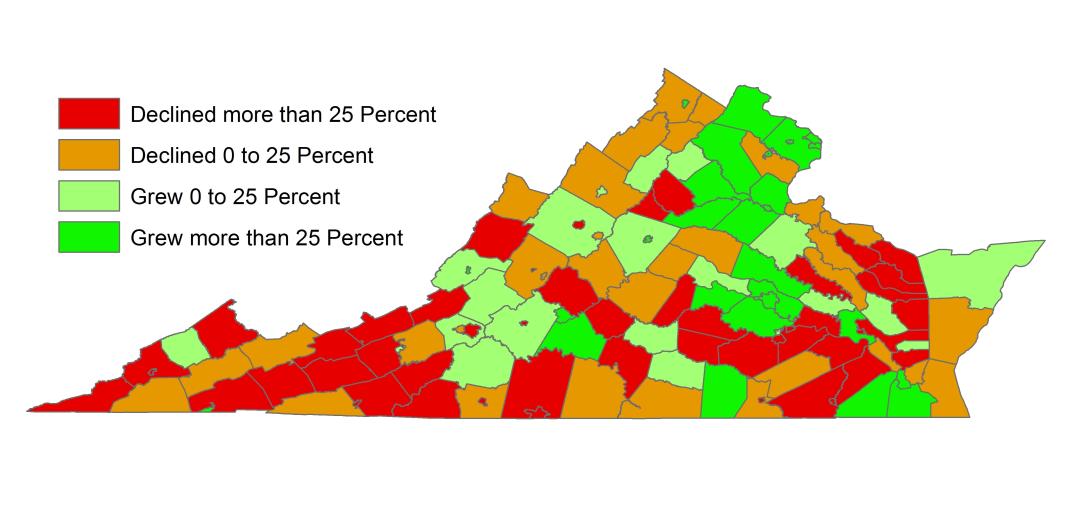
Since the recession, the surprising trend has been that home construction in urban areas has not declined to pre-2000 levels, while it has done so in exurban areas. While the rate of home construction is increasing in both exurban counties and urban centers since 2009 at the same rate, as the charts above show, there is a large disparity in the number of homes constructed in Richmond or Arlington and Caroline or Culpeper. Exurban counties have a long way to go before they return to the heady growth years of the early 2000s.


